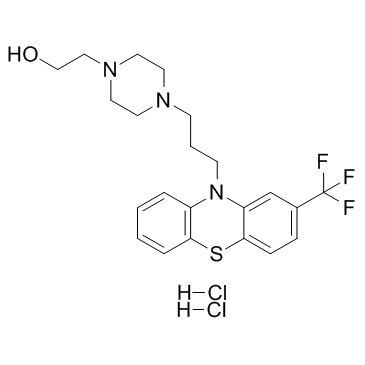Fluphenazine (dihydrochloride)
Modify Date: 2024-01-04 15:26:03

Fluphenazine (dihydrochloride) structure
|
Common Name | Fluphenazine (dihydrochloride) | ||
|---|---|---|---|---|
| CAS Number | 146-56-5 | Molecular Weight | 510.44300 | |
| Density | N/A | Boiling Point | 568.3ºC at 760mmHg | |
| Molecular Formula | C22H28Cl2F3N3OS | Melting Point | 200-202ºC | |
| MSDS | Chinese USA | Flash Point | 297.5ºC | |
| Symbol |


GHS06, GHS08 |
Signal Word | Danger | |
Use of Fluphenazine (dihydrochloride)Fluphenazine dihydrochloride is a phenothiazine-class D1DR and D2DR inhibitor; used to deliver Fluphenazine to biological systems in studies probing the effects and metabolic fates of this commonly used dopamine antagonist. |
| Name | 2-[4-[3-[2-(trifluoromethyl)phenothiazin-10-yl]propyl]piperazin-1-yl]ethanol,dihydrochloride |
|---|---|
| Synonym | More Synonyms |
| Description | Fluphenazine dihydrochloride is a phenothiazine-class D1DR and D2DR inhibitor; used to deliver Fluphenazine to biological systems in studies probing the effects and metabolic fates of this commonly used dopamine antagonist. |
|---|---|
| Related Catalog | |
| References |
| Boiling Point | 568.3ºC at 760mmHg |
|---|---|
| Melting Point | 200-202ºC |
| Molecular Formula | C22H28Cl2F3N3OS |
| Molecular Weight | 510.44300 |
| Flash Point | 297.5ºC |
| Exact Mass | 509.12800 |
| PSA | 55.25000 |
| LogP | 5.85290 |
| Vapour Pressure | 9.41E-14mmHg at 25°C |
| Storage condition | -20°C Freezer |
| Water Solubility | Soluble in DMSO and methanol. |
CHEMICAL IDENTIFICATION
HEALTH HAZARD DATAACUTE TOXICITY DATA
MUTATION DATA
|
| Symbol |


GHS06, GHS08 |
|---|---|
| Signal Word | Danger |
| Hazard Statements | H301-H360 |
| Precautionary Statements | P201-P301 + P310-P308 + P313 |
| Hazard Codes | Xn: Harmful; |
| Risk Phrases | R36/37/38 |
| Safety Phrases | 26-36/37/39-36 |
| RIDADR | UN2811 |
| RTECS | TL9800000 |
| Packaging Group | III |
| Hazard Class | 6.1 |
| HS Code | 3003909090 |
| HS Code | 2934999090 |
|---|---|
| Summary | 2934999090. other heterocyclic compounds. VAT:17.0%. Tax rebate rate:13.0%. . MFN tariff:6.5%. General tariff:20.0% |
|
Inverse agonist properties of dopaminergic antagonists at the D(1A) dopamine receptor: uncoupling of the D(1A) dopamine receptor from G(s) protein.
Mol. Pharmacol. 56 , 989, (1999) The interaction of dopaminergic antagonists with the D(1A) dopamine receptor was assessed in PC2 cells that transiently express this receptor. The maximal binding and dissociation constants for the D(... |
| Mirenil |
| Fluphenazine hydrochloride |
| Prolixin |
| Fluphenazindihydrochlorid |
| Trancin |
| Lyorodin |
| fluorophenazine dihydrochloride |
| Tensofin |
| Moditen |
| Fluphenazine dihydrochloride |
| fluphenazine dihydrodchloride |
| MFCD00055212 |
| Anatensol |
| EINECS 205-674-1 |
| 4-[3-[2-(Trifluoromethyl)-10H-phenothiazin-10-yl]propyl]-1-piperazineethanol dihydrochloride |
| Fluphenazine (dihydrochloride) |

